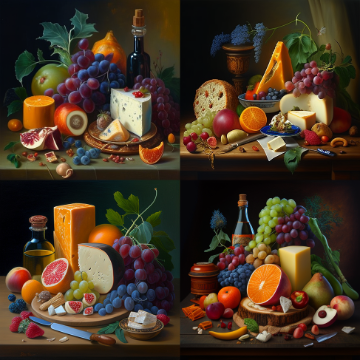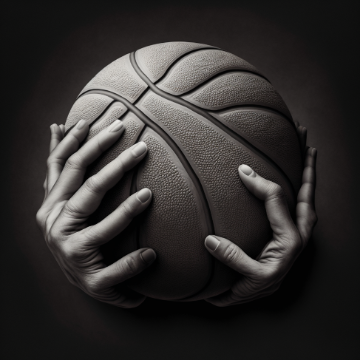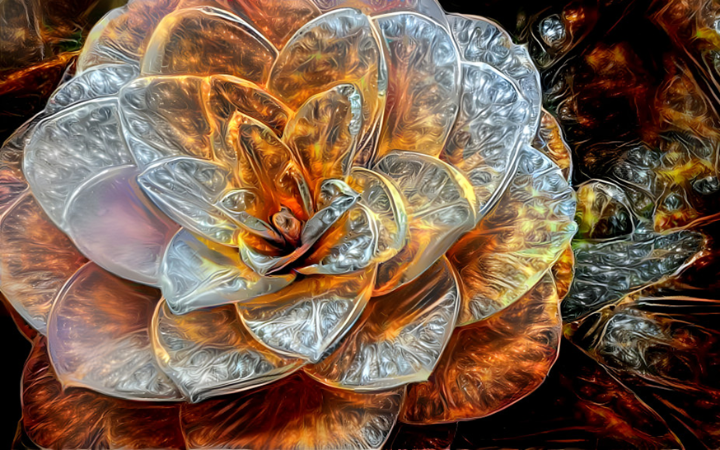
Photo: Midjourney image “oil painting still life with fruit, nuts, vegetables, meat, and cheese, colorful” is licensed under CC NonCommercial 4.0.
Brian Patrick Green is the director of technology ethics at the Markkula Center for Applied Ethics. Views are his own.
With the release of DALLE-2 and ChatGPT, OpenAI has made clear that generation of both text and images (for here onwards, for simplicity: “art”)--things that formerly only humans could do–is no longer our exclusive power. If we thought it was sufficient to educate young people so that they can write or draw, we might want to reconsider our goals for lack of ambition. With the rise of AI, mere text or art is no longer good enough. What is needed now are text and art that are truly human, and that requires knowing what it means to be truly human. In Part 1, I will consider AI-generated art, and then text in Part 2.
AI-generated art, first of all, should not be considered to be art in the same way that human generated art is considered. AI-generated art is based on statistical aggregations of pixels designed to be pleasing to the human eye, based on the database and algorithms forming the AI model, and the text prompting that model. In philosophical language, the “art” generated is more of a “heap” than a “whole.” It is a pleasant arrangement of dots, matching patterns that humans recognize as faces, objects, and concepts, but the AI itself does not understand what it is doing. There is no “wholeness” to the image – the parts do not logically connect to the whole, or they connect, but not in the right way. Sometimes, a wheel of cheese has one face that is the inside of an orange (see Image 1, upper right). Sometimes parts appear that make no sense: eyes are misplaced, or there are too many fingers (see Image 2).

Image 2: Midjourney image: “two hands holding a basketball," licensed under CC NonCommercial 4.0.
These artistic errors will likely be corrected in the future, but for now they belie an important truth: the AI does not know what it is doing. It does not know how many fingers a human has because it does not know what fingers are, much less what a human is. Instead, what the AI has is a statistical correlation between words and pixels–a remarkable one to be sure–but not a functional understanding of what those correlations mean in reality.
Keeping the statistical nature of AI in mind, it should be no surprise that images can be created by AI. Take a look at a million pictures. The conceptual subject of the image will be nearer the center. Certain types of images have clear patterns to them: an automobile will have 4 wheels, two on each side; a tree will have a trunk with branches and leaves above that, and so on. The colors follow patterns, the lines and edges follow patterns. But placing pixels in a statistically plausible layout is not art.
Art goes a layer deeper than that. Art is not a pile of pixels, it is a whole image imbued with meaning by the mind of its creator. The image has significance because it was made with significance in mind.
In defense of AI art, the artists who use AI as an art-making tool do have significance in mind. I have used AI image generators to make pieces of art, several of which have been used with academic articles and even a book cover. There is meaning in AI art, but it is not meaning put there by the AI, but rather by the human mind that is using the AI as a tool like a brush and palette. When I put pictures or prompts into the Deep Dream Generator, it takes a lot of work to figure out what might look good. When prompting Midjourney or DALLE-2, it takes some skill to figure out the right words to use in order to get the result that you want. Over the last year, I’ve made hundreds of images with AI, and only a few of them are any good. The rest reflected my lack of skill and the vagaries of an AI tool that makes images based on statistical magic, and often yields hands with seven fingers.

Additionally, there is also another source of human skill in AI art–the skill of the AI programmers themselves. And this is a tremendous skill to be sure. The idea of being able to type words into a prompt, have those words engage an AI model which binds together unbelievably advanced mathematics with an incomprehensibly massive database of images, and all run on computers that are intricate beyond our ability to conceive–that is a truly human accomplishment. Humans built that, and all of us can be impressed by the socio-technical system that allows folks to sit at their computers and make art from text.
As a last point, the database of work that generative models are built upon represent years of skill development and labor of human artists who created those works. Their work has meaning too, and they (and their meanings) are too often ignored when it comes to generative AI. Few artists (perhaps none!) gave consent for their images to be used to train these generators, and thus these generators are also an unjust appropriation of human skill and labor. If artists have their work being used in an AI model, they deserve some form of compensation, and we should keep this in mind when we look at, create, use, and critique AI art.

Image 4: Deep Dream of St. Peter’s Basilica in Rome in the style of Vincent van Gogh’s “Starry Night” (cropped). How would van Gogh feel about this use of his work? *
AI-generated art, then, is a truly human accomplishment, while at the same time being alien in many ways, and alienating of artists. AI art generation transfers art-generating power from particular individuals to a machine embedded in a vast and complex socio-technical system–a system that in itself has the generic goal of generating “art,” but the specific goals of which come from users. It is a delegation of art-making power from humans, to machines, and back to humans again, but re-ordering the distribution of artistic abilities in society.
In conclusion, in the context of education, students–and all people–should remember not only the above but also this: fundamentally, the meaning of art remains in human minds. The art itself has a human meaning in it if a human created it with meaning in mind, and the AI tool is the medium of conveying that meaning, not itself the source of meaning. AI-generated art is the automated artifice of human artifice–a remarkable achievement to be sure, but no more significant or less significant than the human work that made it such.
Part 2: AI Generated Text
* Image used previously here: https://jmt.scholasticahq.com/issue/4236-vol-11-issue-special-issue-1-2022
All images created by Brian Patrick Green using the programs mentioned in the captions.
